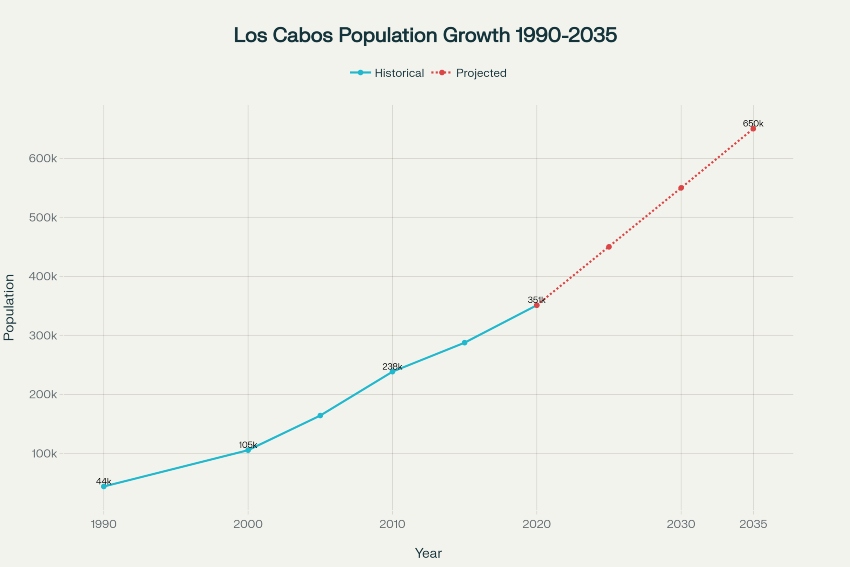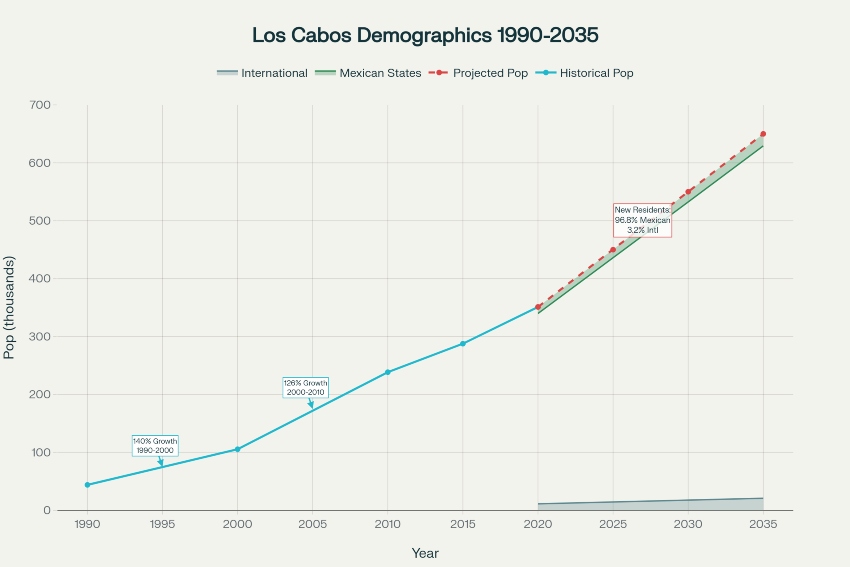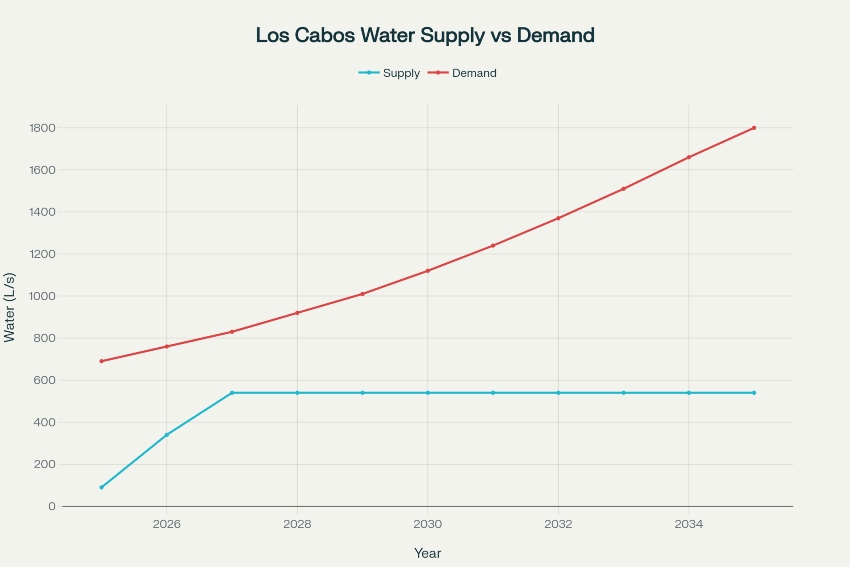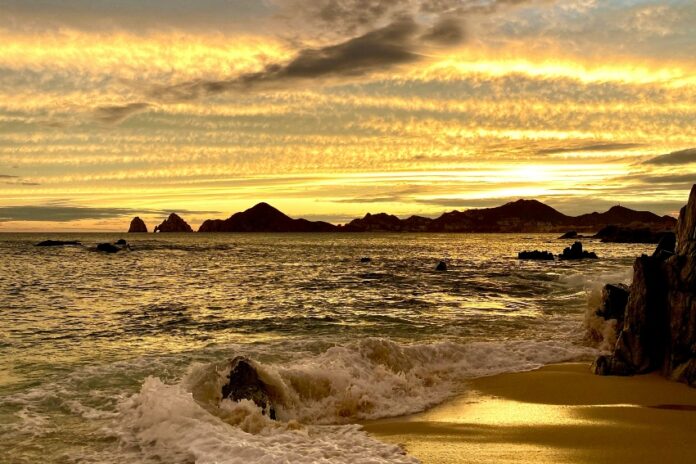There is no end in sight for the explosive population growth that has taken Los Cabos from 44,000 residents as recently as 1990 to over 350,000 by 2020. In fact, according to estimated growth models, the population is projected to nearly double again by 2035.
That means in 2035, only a decade from now, Los Cabos is poised to be home to between 600,000 and 650,000 residents. Obviously, this kind of sustained growth at such a high rate comes with serious infrastructure challenges, some of which — like traffic and housing and water supply shortages — are already obvious to residents.

But assuming population trends continue, and there’s no reason to think they won’t — Los Cabos, for example, continues to maintain an annual 14-16% growth rate well above the national average — I thought it would be interesting to take a peek into the future and see what will be different about Los Cabos a decade from now, and what may still be the same.
What is the plan for Los Cabos?
The first thing to note is that a governmental plan is in place to manage this significant growth. The first iteration of this appeared in 1999 under the title “Plan Director de Desarrollo Urbano de San José del Cabo y Cabo San Lucas, B.C.S.” It aimed at a responsible development of tourism infrastructure for the destination. However, by the time the second edition appeared in 2013 as “Plan Director de Desarrollo Urbano (PDU 2040),” the focus had shifted to responsible and sustainable residential growth by the year 2040 (hence, the title), with emphasis on such topics as expansion vision, designated growth areas, managing housing and water crises and infrastructure upgrades.
A third edition of this plan is expected to be completed soon, and yes, there is a participatory public element involved. For instance, over 40 workshops were held, involving over 700 participants, to garner input on the future direction of the Los Cabos municipality for the second update in 2013. Public input has also been sought for the third edition, although exactly how much remains uncertain.
If those seem like very small numbers relative to the population and its needs, they are. But decisions on the future of the destination have been made. That they’re already moving forward is evident in several of the upgrades that will be discussed shortly.
Demographics
So, where are the nearly 300,000 or so new residents moving to Los Cabos over the next decade coming from? Contrary to concerns about gentrification, a hot-button topic in Mexico at the moment, there won’t be any mass influx of foreigners, either from the U.S. or elsewhere. Currently, there are just over 17,400 foreign residents in the municipality, representing less than 5% of the total population. About 10,000 more are expected in the next decade, which sounds like a lot. However, due to the overall immigration pattern, this will have no meaningful effect on the percentage of foreign nationals. Rather, the mass of newcomers will be overwhelmingly Mexican, no doubt seeking new jobs and opportunities in a high-growth region.
Currently, more than half the population of Baja California Sur was born in another state in Mexico, and that trend should continue with new arrivals mainly coming from Guerrero, Sinaloa, Mexico City and Estado de Mexico. Los Cabos, one of only five municipalities in the state, already accounts for a whopping 44% of its total population, and that number should hit 50% by 2035.

Tourism Infrastructure
Tourism in Los Cabos is being carefully and expertly managed, with Rodrigo Esponda, managing director of the Los Cabos Tourism Board, noting that the emphasis remains on sustainable growth that maintains the destination’s relatively newly acquired patina as a luxury getaway.
Still, both the number of hotel rooms and the tourists occupying them could increase significantly over the next 10 years due to increased connectivity and infrastructure upgrades. Currently, there are about 20,0000 available rooms for the four million tourists who visit annually. By 2035, the former figure will certainly pace upwards based on announcements for new resorts, although it’s hard to forecast how much.
What’s undeniable is that future growth is being facilitated by upgrades underway at the Los Cabos International Airport, to enable it to handle up to 40% more volume, including passengers from the new routes coming from North America, Europe, Central and South America. So, Los Cabos is well-placed to continue its steady tourism growth, while maintaining higher-than-average spending rates.
Traffic and water challenges
Traffic, although certainly a concern at present due to the lengthy but much-needed infrastructure upgrade to the Fonatur roundabout in San José del Cabo, which an estimated 60,000-plus vehicles use daily, is expected to accommodate the expected growth. Not only will a third artery be built between Cabo San Lucas and San José del Cabo, called the Eje Interurbano (Interurban Axis), to help divert overflow from Federal Highway 1 and the toll road, but mass transit improvements are also in the works, including the possibility of electric bus service.
These improvements should make traffic between the cape cities flow much smoother, although the residential sprawl of overtaxed surface streets is likely to remain a persistent irritant to anyone who wants to go somewhere in a hurry.
The most concerning issue, meanwhile, is likely to be water management. Currently, for example, Los Cabos is running at a deficit of 600 liters per second.

Yes, reinforcements are on the way, including the opening of a second desalination plant in Cabo San Lucas by 2026, plus a few privately owned resort and residential desalination projects by 2027. But demand (see the graph above, which is based on conservative estimates relative to rising population figures and traditional usage) is expected to increase significantly in the coming decade.
Housing concerns
Another area of concern over the next decade will be housing. As I referenced in my recent article on wealth disparity in Los Cabos, there is a dearth of affordable housing in Los Cabos, either homes or rental units. So if it’s bad now, what’s going to happen with up to 300,000 more residents moving in by 2035?
The premier coastal tracts will continue to be reserved for high-end real estate development, with the East Cape of Los Cabos a likely contested patch between long-time residents trying to fight off exploitative growth and environmental degradation, and resort and residential speculators licking their chops over how much pristine land remains. Four Seasons kick-started the luxury rush of the East Cape in 2019 with its impressive Costa Palmas resort and residences. Aman’s Amanvari is coming soon, and high-end hospitality brands Delano and Raffles have announced the opening of East Cape resorts and residences by 2029.
Those residences, however, are for the privileged few. For the many, Cabo San Lucas and San José del Cabo can expect more sprawl into outlying areas, like the former’s Leonardo Gastelum colonia or El Tezal. Housing initiatives, including those locally endorsed by President Sheinbaum, have largely been stymied due to the difficulty of acquiring tracts of land at affordable prices. More initiatives will certainly be introduced, but the underlying issue remains.
What else could change?
These, of course, are only some of the more immediate concerns. There are others, too. What will a rapidly increasing population mean for farm-to-table food supply, or for the environment, including the spectacular natural beauty and amazing flora and fauna that have made Los Cabos such an attractive destination in the first place? The answers to these questions remain to be seen. Only one thing can be said with certainty: the next 10 years in Los Cabos will be interesting, to say the least.
Chris Sands is the former Cabo San Lucas local expert for the USA Today travel website 10 Best and writer of Fodor’s Los Cabos travel guidebook. He’s also a contributor to numerous websites and publications, including Tasting Table, Marriott Bonvoy Traveler, Forbes Travel Guide, Porthole Cruise, Cabo Living and Mexico News Daily.
